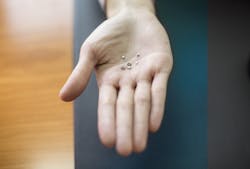SiTime Rolls Out Oscillators for Aerospace and Defense Markets
SiTime introduced a new range of rugged oscillators for aerospace and defense applications, as the Santa Clara, California-based company aims to expand its share of the more than $6 billion timing device market. The new parts are designed to resist vibrations, severe temperatures, pressure, airflow, electromagnetic interference and other rough-and-tumble conditions faced by airplanes, satellites and defense electronics
SiTime sells timing solutions based on microelectromechanical systems, or MEMS, instead of the tiny crystals typically used to spit out the timing signals that form the heartbeat of every electronic device. SiTime's MEMS can better withstand harsh conditions in large part because they weigh a small fraction of crystal components. They also claim lower power and higher reliability, though they generally cost more than crystal devices.
Its latest line of oscillators, Endura, are able to hold out against acceleration forces that can undermine the accuracy of timing signals used in aerospace and defense. The chips can also better endure vibrations that can degrade performance. SiTime said its new oscillators have up to 50 times better acceleration sensitivity. The chips can also deliver up to 20 times better tolerance for mechanical shock and 3.5 times more vibration performance.
SiTime said all its Endura devices meet MIL-PRF-55310 and MIL-STD-883 standards.
"When exposed to high levels of shock, vibration and extreme temperatures, legacy timing components have been prone to failure, degrading system performance and reliability,” said Piyush Sevalia, vice president of marketing at SiTime, which is also trying to swipe market share in in cars, factories and other high-reliability systems. He believes that SiTime's Endura oscillators "will transform the oscillator landscape in aerospace and defense.”
SiTime's Endura devices are targeted at customers that need voltage-controlled oscillators (VXCOs) that put out different frequencies based on the input voltage, temperature-compensated oscillators (TCXOs) that better tolerate heat fluctuations, digitally-controlled oscillators (DCXOs) and standard oscillators (XOs), among others. The Endura family spans 17 separate products, which can be programmed into 5 million different part numbers.
The Endura oscillators are based on a programmable analog architecture, which makes it possible to program them to any frequency between 1 MHz and 725 MHz depending on the type of oscillator used. Operating voltage and stability are also open to programing. The product line can tolerate temperatures ranging from -55°C to +125°C. The chips are sampling today and are set to enter volume production in the fourth quarter of 2019.
About the Author

James Morra
Senior Editor
James Morra is the senior editor for Electronic Design, covering the semiconductor industry and new technology trends, with a focus on power electronics and power management. He also reports on the business behind electrical engineering, including the electronics supply chain. He joined Electronic Design in 2015 and is based in Chicago, Illinois.
